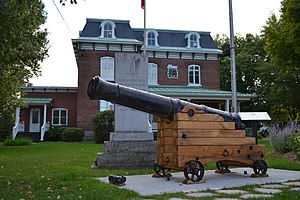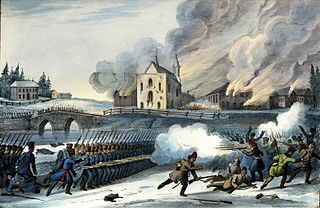
The Lower Canada Rebellion, commonly referred to as the Patriots' Rebellion in French, is the name given to the armed conflict in 1837–38 between rebels and the colonial government of Lower Canada. Together with the simultaneous rebellion in the neighbouring colony of Upper Canada, it formed the Rebellions of 1837–38.
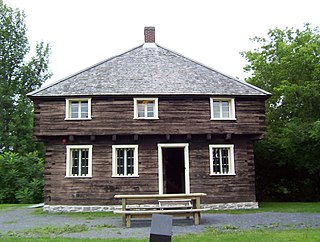
The Battle of Lacolle River was fought on November 20, 1812, during the War of 1812. In this relatively light skirmish, a very small garrison of Canadian militia, with the assistance of Kahnawake Mohawk warriors, defended the Lacolle Mills Blockhouse on the Montreal road bridge over the Lacolle River at the village of Lacolle, Quebec against a disorganized American attack.

The Battle of Lacolle Mills was fought on 30 March 1814 during the War of 1812. The small garrison of a British outpost position, aided by Canadian reinforcements, fought off a large American attack.

The Battle of Saint-Charles was fought on 25 November 1837 between the Government of Lower Canada, supported by the United Kingdom, and Patriote rebels. Following the opening Patriote victory of the Lower Canada Rebellion at the Battle of Saint-Denis, British troops under the command of Lieutenant Colonel George Wetherall advanced from the south on the Patriote stronghold of Saint-Charles in the Richelieu valley. On 25 November 1837 they engaged the Patriote forces under the command of Thomas Storrow Brown. After a two-hour battle, the Government of Lower Canada was victorious.
The Battle of Beauharnois was fought on November 10, 1838, between Lower Canada loyalists and Patriote rebels, after 500 armed men had converged on Beauharnois, on November 3–4, overtaking the seigneurial manor.

Hemmingford is a township municipality in south-west Quebec. The population as of the 2021 Canadian census was 1,995. The township completely surrounds the Village of Hemmingford. The two entities are locally referred to collectively as Hemmingford. The two share many things, such as the cost of the volunteer fire department, and both hold their councils and offices in the same building in the village.
Ferdinand-Alphonse Oklowski was a military officer of Polish origin. As a colonel, he took part in the second uprising of the Lower Canada Rebellions as he commanded the Patriote forces in the Battle of Lacolle, on November 6 and November 7, 1838. The Patriote won the first skirmish of November 6 but lost the final confrontation the next day.

The Battle of Odelltown was fought on November 9, 1838, between Loyal volunteer forces under Lewis Odell and Charles McAllister and Patriote rebels under Robert Nelson, Médard Hébert and Charles Hindelang. The rebels were defeated in this battle, one of the last of the Lower Canada Rebellion of 1838.
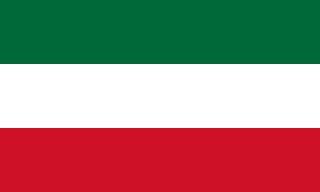
The Republic of Lower Canada was a break-away state proclaimed in the aftermath of the 1837 Rebellions. The defeat of the rebellion meant that the state could never be properly established.

The Patriote flag was used by the Patriote movement in Lower Canada between 1832 and 1838.
Odelltown is a former town in southern Quebec, Canada located on Route 221, 4.7 km (2.9 mi) south of Lacolle, Quebec. The settlement was named after Joseph Odell, a United Empire Loyalist and Founder Pioneer of the Odell Family in Odelltown, Province of Lower Canada. The hamlet has since been made part of Lacolle. The area was the scene of a battle on 28 June 1814 during the War of 1812 between American and British forces. It resulted in a British victory. Odelltown was also the scene of two engagements between rebels and loyalists during the Lower Canada Rebellion between 7 November 1838 and 9 November 1838. Both engagements resulted in loyalist victories.

Lacolle is a municipality in southern Quebec, Canada, located in the administrative area of the Montérégie, on the Canada–United States border. The population as of the Canada 2021 Census was 2,708. The Lacolle River runs eastward through the middle of the town and empties in Richelieu River. More people cross the border illegally from the United States there than at any other point. Almost nineteen thousand people were detained in 2017. The nearest town across the border is Champlain, New York.

Chitaraque is a town and municipality in the Ricaurte Province, part of the Colombian department of Boyacá. The urban centre is located at a distance of 104.6 kilometres (65.0 mi) from the department capital Tunja and situated at an altitude of 1,575 metres (5,167 ft) in the Eastern Ranges of the Colombian Andes. It borders Gámbita, Santander in the east and south, San José de Pare, Santana and Togüí in the west and Suaita, Santander in the north.

Beauharnois is a city located in the Beauharnois-Salaberry Regional County Municipality of southwestern Quebec, Canada, and is part of the Greater Montreal Area. The city's population as of the Canada 2021 Census was 13,638. It is home to the Beauharnois Hydroelectric Power Station, as well as the Beauharnois Lock of the Saint Lawrence Seaway.

Lacolle Mills Blockhouse is a blockhouse and museum located alongside the Lacolle River near the village of Lacolle, Quebec.

Lieutenant-Colonel Maximilien Globensky was a French-Canadian who fought for the British in the War of 1812 and for the loyalists in the Rebellions of 1837.
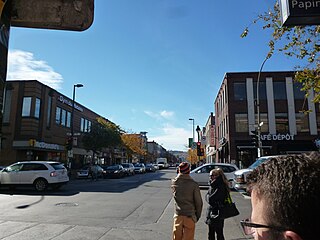
Papineau Avenue is the longest north–south street in Montreal, Quebec, Canada. The part of the street between Henri Bourassa Boulevard and Quebec Autoroute 40 is the Montreal portion of Quebec Autoroute 19, commonly referred to as Autoroute Papineau. North of Henri Bourassa Boulevard, it becomes a true autoroute before crossing the Rivière des Prairies on the Papineau-Leblanc Bridge. In the south, the avenue ends at Notre-Dame Street.
Notre-Dame-du-Mont-Carmel was a former parish municipality in Le Haut-Richelieu Regional County Municipality in the Montérégie region of Quebec. On September 13, 2001, it ceased to exist and merged with the village municipality of Lacolle to form the new municipality of Lacolle.
The Battle of Baker's Farm took place in Lower Canada on November 8, 1838, during the Patriot's War. It was the first and last military success of the Patriotes in the campaign of 1838. Eight hundred Patriotes gathered on a farm near Sainte-Martine, Quebec and fought off several attacks by Loyalist volunteers. After news of the defeat of Patriotes forces at the Battle of Odelltown spread, the massed Patriotes dispersed before the arrival of British troops.
